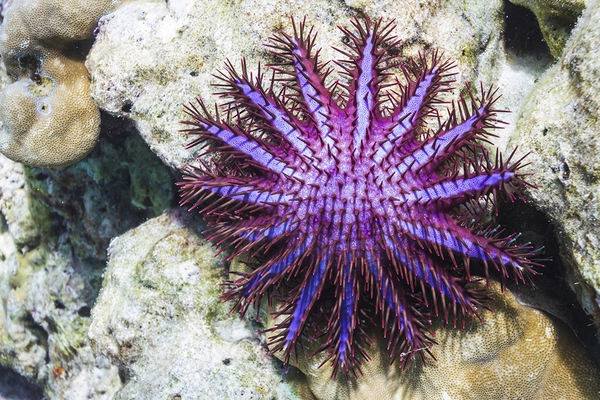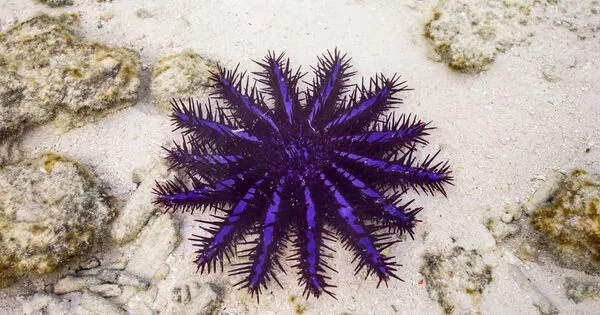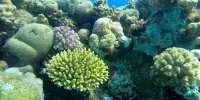Crown-of-thorns starfish (COTS) are marine invertebrates that feed on coral. They occur naturally on reefs throughout the Indo-Pacific region, and when conditions are favorable, they can reach plague proportions and devastate hard coral communities. LMU researchers have identified coral-eating crown-of-thorns seastars in the Red Sea as a distinct species found only in this region.
Tropical coral reefs are among the world’s most endangered ecosystems. Aside from climate change, coral-eating crown-of-thorns seastars (Acanthaster spp.) are a major threat in parts of the Indo-Pacific region. These creatures, which can grow to be up to 40 cm long, primarily feed on the polyps of fast-growing stony corals. Mass outbreaks are not uncommon, in which seastars reproduce rapidly and thousands of individuals can destroy large areas of coral reef. Such mass outbreaks have become more common in recent decades, owing in part to overfishing, which has decimated the seastars’ natural enemies.
Crown-of-thorns Seastars are found throughout the Indo-Pacific region. The large venomous spines that protrude from their arms give them their name. Various species had previously been described based on regional morphological differences. However, their relationships remained a little hazy.
It was long assumed that Acanthaster planci, the first species described in the genus, was distributed from the Red Sea and the Indian Ocean across the entire Pacific.
Prof. Gert Wörheide
“It was long assumed that Acanthaster planci, the first species described in the genus, was distributed from the Red Sea and the Indian Ocean across the entire Pacific,” says Gert Wörheide, Professor of Paleontology and Geobiology at LMU. However, more than a decade ago, DNA barcoding data from a doctoral thesis supervised by Wörheide revealed that A. planci can be subdivided into four strongly diverging genetic lineages, which presumably represent different species.
A team led by Wörheide and Gerhard Haszprunar, Professor of Systematic Zoology at LMU, has now demonstrated with the aid of morphological investigations and genetic analyses that the crown-of-thorns seastar native to the Red Sea form a distinct species, which has been given the name Acanthaster benziei.
“This underlines once again the importance of the Red Sea as an ecosystem with unique fauna and numerous endemic species,” emphasizes Wörheide. The new species name honors John Benzie, Professor at University College Cork, who has done pioneering work with his groundbreaking genetic studies on crown-of-thorns seastars in the 1990s and his comprehensive collection.

Fewer arms, thinner spines
For the first time in decades, the scientists were able to describe a new species of crown-of-thorns seastar with A. benziei. “Although isolated specific features had already been observed in Red Sea crown-of-thorns seastars, such as a tendency to a more nocturnal lifestyle and possibly lower toxicity of the spines, we didn’t know that it was actually a distinct species,” Wörheide explains.
The study found clear distinctions between A. benziei and the other species in the “A. planci” species complex. This included morphological features such as fewer arms and thinner, differently shaped spines, in addition to distinctive mitochondrial DNA sequences.
“Now that we know it’s a distinct species, we can direct our attention to the biology, ecology, and toxicology of A. benziei and the other Acanthaster species,” says Wörheide. In the past, scientists had also observed a lower tendency for mass outbreaks in Red Sea crown-of-thorns seastars.
“Such outbreaks are known primarily from Acanthaster cf. solaris in the western Pacific and regularly cause major damage to the Great Barrier Reef, whereas the phenomenon appears to be less severe in the Red Sea — whether species-specific characteristics are a contributing factor could be the subject of future investigations,” Wörheide says.
Acanthaster cf. solaris from the western Pacific has provided the majority of the data on the biology and ecology of crown-of-thorns seastars to date. “We can conduct more detailed research into the dynamics of mass outbreaks, one of the many stressors that affect tropical reefs, by clearly distinguishing the various species of coral-eating crown-of-thorns seastars. Finally, this is a step toward better reef ecosystem management.”















